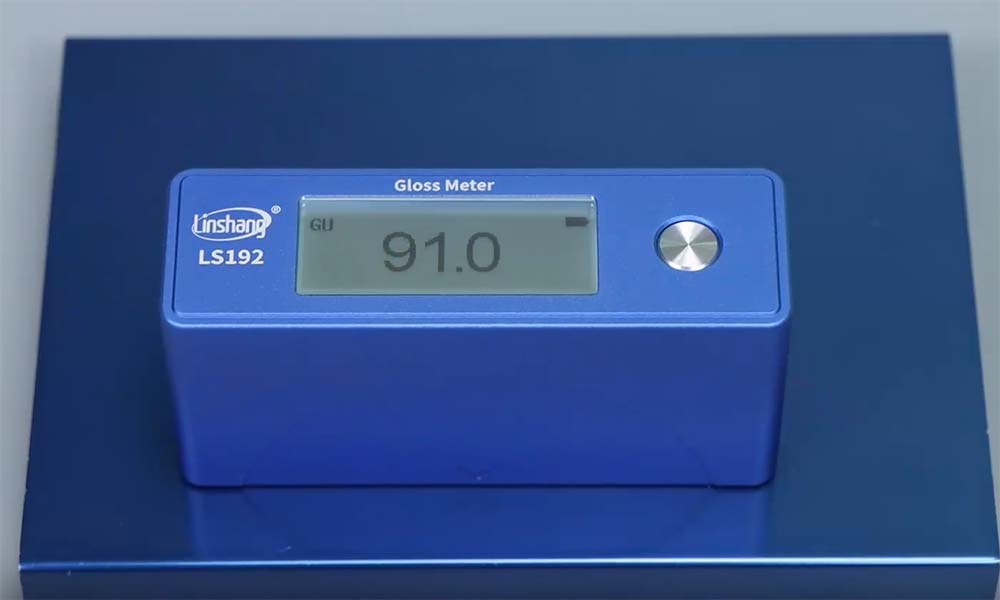How does the paint gloss meter judge the gloss of paint?
Paint, as a common coating, will affect the surface gloss of the covered object. The high gloss of the paint will make the object look more translucent. Depending on the application, the paint gloss of different objects will be different, which can be assessed with a paint gloss meter. Let's find out how to judge specifically!

Definition of paint gloss
First you need to understand what paint gloss is. Glossiness, simply put, is the specular reflection ability of an object's surface to light. Paint gloss refers to the specular reflection ability of the paint surface against light after it is coated with paint on the surface of an object. Currently, paints on the market can be divided into matte paint, matte paint, semi-gloss paint, and high-gloss paint according to different gloss levels. How to divide it specifically requires the use of a paint gloss meter.
Assessing the glossiness of paint with the gloss meter
So, why use a gloss meter to determine paint gloss? First of all, because different ambient light will affect our perception of the gloss of an object, if we only rely on the naked eye to judge, it is easy to produce deviations. Moreover, judging glossiness by naked eyes is also subjective and unconvincing.
In addition, for professional painters, gloss is more complicated and the difference is only subtle. If a gloss meter is used to assist communication and confirmation during the project, a certain amount of time and cost waste can be reduced. Moreover, in large-scale commercial or industrial coatings, it is necessary to ensure that the entire coating job is uniform. The gloss of the coating is not only affected by the inherent gloss of the coating, but also by multiple factors such as the substrate, temperature, and coating thickness. Different gloss levels affect not only the appearance, but also pollution resistance, moisture resistance, whether damage is obvious, etc.
Therefore, it is necessary to borrow corresponding instruments to make objective, professional and accurate judgments of gloss according to certain standards. This instrument is the Linshang Paint Gloss Meter, which is specialized in measuring gloss.

How to judge paint gloss
1. National relevant standards
In the national standard GB/T9754-2007, a clear determination method is proposed for the glossiness of paints, varnishes, paint films without metallic pigments, etc., which are measured under 20°, 60° or 85° geometric conditions. The three measurement angles of 20°, 60°, and 85° refer to the angle between the normal line perpendicular to the surface of the measured object and the incident beam. 60° is suitable for all paint films, 20° is more suitable for high-gloss paint films, that is, paint films with a 60° mirror gloss higher than 70 units, and 85° is suitable for low-gloss paint films, that is, those with a 60° mirror gloss lower than 10 units. paint film. Generally speaking, paint can be measured at a universal angle of 60°.

2. How to measure gloss with the paint gloss meter
The measurement of specular gloss is a relative value. The reference standard is that polished black glass with a refractive index of 1.567 is given a geometric condition of 20 degrees, 60 degrees, and 85 degrees. The specular gloss value is defined as 100. The Linshang paint gloss meter is equipped with a standard plate. When the light source and receiver are at a fixed angle, the light flux reflected by the light beam shining on the sample is divided by the light flux reflected by the standard plate, and then multiplied by the gloss value of the standard plate, which is the sample. glossiness.
According to the universal angle of 60°, use the Linshang 60° angle paint gloss meter to test. The glossiness can be judged as matte paint if it is less than 20GU, and as matte paint if it is less than 30GU; between 40-60GU as semi-gloss. Paint, high-gloss paint 70GU or more.
Before turning on the instrument for measurement, you can calibrate it first. Linshang glossmeter allows long-term calibration. It is not necessary to calibrate every time. Please note that the standard plate needs to be kept clean. Enter the measurement interface, remove the standard plate, place the instrument on the sample to be measured, and you can get the data. The key on the instrument is a lock key, which can lock the data.

Paint gloss meter measures spray paint materials

Paint gloss meter measures wood board varnish
The above is the judgment method of Linshang paint gloss meter. With the help of a professional gloss meter, you can help determine the paint grade and provide data support for project work. For more information, please contact us.
- Linshang Portable Colorimeter & Spectrophotometer Selection and FAQ
- How to Check Whether the UV of Air Disinfector Meet the Standards?
- How do I use a gloss meter to measure gloss?
- Linshang Insulated Glass Unit Measuring Tools
- Outstanding Advantages of UV LED UV Energy Meter
- Difference between LS103A and LS183 spectrum transmission meter